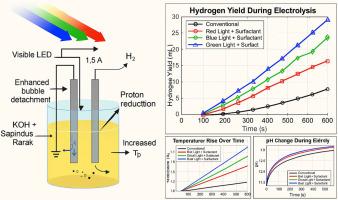生物表面活性剂与可见光协同增强碱水电解析氢反应
IF 3.9
3区 工程技术
Q3 ENERGY & FUELS
Chemical Engineering and Processing - Process Intensification
Pub Date : 2025-09-30
DOI:10.1016/j.cep.2025.110567
引用次数: 0
摘要
本研究提出了一种绿色且可扩展的策略,通过将天然生物表面活性剂皂角与可见光照射相结合,来促进碱性水电解过程中的氢析出。电解实验采用30 vol% KOH电解质,外加0.5 M皂角提取物,在700流明的红、绿、蓝LED照明下进行。在9 V和1.5 A电解10分钟后,与暗条件相比,氢气产量显著增加:从8.3 mL(对照)到16.5 mL(红色),23.6 mL(绿色)和29.1 mL(蓝色)。这些增强是由于皂苷基表面活性剂降低表面张力和高能光子的光热激活的协同作用。蓝光具有最高的光子能量(约2.75 eV),引起最大的温升和she加速度。在联合处理下,体系表现出更好的传质、更小的气泡直径、更高的pH值和更高的电流密度。FTIR和UV-Vis分析证实了生物表面活性剂的两亲性和光响应性。研究结果表明,将可再生添加剂与光能相结合,为提高氢气产量提供了一条具有成本效益的途径,与可持续能源目标保持一致。本文章由计算机程序翻译,如有差异,请以英文原文为准。

Synergistic enhancement of hydrogen evolution reaction by bio-surfactant and visible light in alkaline water electrolysis
This study presents a green and scalable strategy to enhance hydrogen evolution in alkaline water electrolysis by integrating a natural bio-surfactant, Sapindus rarak, with visible light irradiation. Electrolysis experiments were conducted using 30 vol% KOH electrolyte supplemented with 0.5 M Sapindus rarak extract under red, green, and blue LED illumination (700 lumens). After 10 min of electrolysis at 9 V and 1.5 A, hydrogen yields increased significantly compared to the dark condition: from 8.3 mL (control) to 16.5 mL (red), 23.6 mL (green), and 29.1 mL (blue). These enhancements are attributed to the synergistic effects of reduced surface tension by the saponin-based surfactant and photothermal activation from high-energy photons. Blue light, having the highest photon energy (∼2.75 eV), induced the greatest temperature rise and HER acceleration. The system exhibited improved mass transfer, smaller bubble diameters, elevated pH, and increased current density under combined treatments. FTIR and UV–Vis analyses confirmed the amphiphilic and photoresponsive nature of the bio-surfactant. The findings demonstrate that combining renewable additives and light energy offers a cost-effective pathway to boost hydrogen production, aligning with sustainable energy goals.
求助全文
通过发布文献求助,成功后即可免费获取论文全文。
去求助
来源期刊
CiteScore
7.80
自引率
9.30%
发文量
408
审稿时长
49 days
期刊介绍:
Chemical Engineering and Processing: Process Intensification is intended for practicing researchers in industry and academia, working in the field of Process Engineering and related to the subject of Process Intensification.Articles published in the Journal demonstrate how novel discoveries, developments and theories in the field of Process Engineering and in particular Process Intensification may be used for analysis and design of innovative equipment and processing methods with substantially improved sustainability, efficiency and environmental performance.

 求助内容:
求助内容: 应助结果提醒方式:
应助结果提醒方式:


